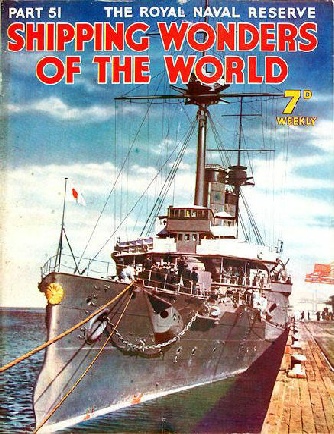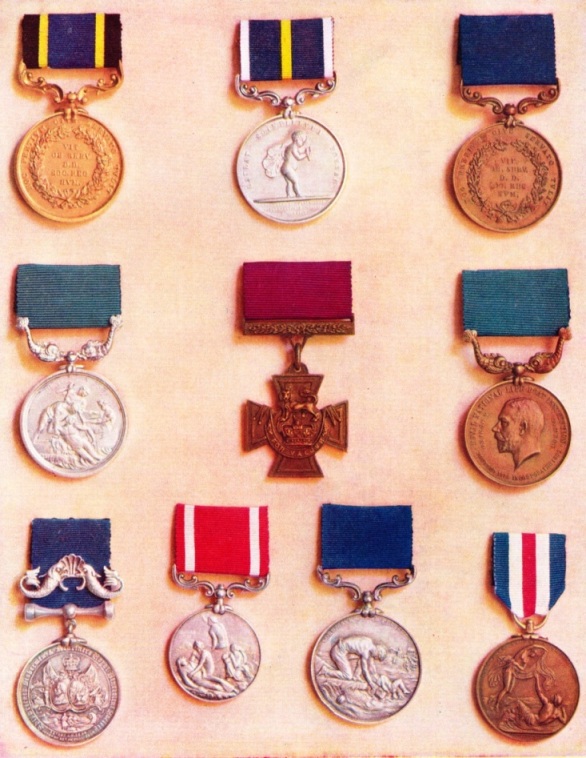
© Shipping Wonders of the World 2012-



Part 51
Part 51 of Shipping Wonders of the World was published on Tuesday 26th January 1937.
This issue included a colour plate illustrating Medals Awarded for Conspicuous Gallantry and Life-Saving at Sea . It formed part of the chapter on Medals for Acts of Bravery. The plate was attached to page 1613 of this part.
The Cover
This week’s cover shows the Japanese cruiser Yakumo berthed at Port Melbourne after the arrival there of the Japanese training squadron in April 1935. The Yakumo, which is used as a midshipmen’s training ship, has a displacement tonnage of 9,010, a length between perpendiculars of 390 feet and a beam of 64¼ feet.

Contents of Part 51
Cable Ships at Work
This is the second chapter on the work of the cable ships; an earlier article being on Laying the Ocean Cables. The article is concluded from part 50.
Storm and Tempest at Sea
All over the Seven Seas there are regions, well known to seamen, where bad weather may generally be expected, though storms are not confined to these regions. The sailor of to-day, however, is more fortunate than his predecessors, since he is generally warned of an approaching storm and is thus able to take precautions against it. Tyneside readers will be familiar with the famous Calliope, now an RNVR drill ship. She is known to the Navy, not inappropriately, as the “Hurricane Jumper”, a title which was bestowed on her after the famous hurricane of 1889, when she safely made her way out of the harbour of Apia, Samoa. This chapter deals with cyclones, typhoons, hurricanes and so forth.
Medals for Acts of Bravery
Acts of conspicuous gallantry performed amid the perils of the sea are rewarded by the presentation of a limited number of medals to which great honour is attached. The heroes of peace deserve equal renown with heroes of the battle area - perhaps more, for their endeavours are always directed to the preserving of human life. Among such heroes are the gallant lifeboatmen, sailors and others who risk their own lives in the attempt to save their fellows.
Medals for Acts of Bravery (colour plate)
Medals for Acts of Bravery
Key to the colour plate
THE VICTORIA CROSS, which, with its blood-red ribbon, is probably the best known of all decorations, is shown in the centre of the colour plate. Reading from left to right, the first medal shown is the Stanhope Gold Medal, which was instituted in memory of Captain C S S Stanhope RN, who died in 1871. The medal is awarded by the Royal Humane Society for the bravest life-saving deed of the year. The silver and bronze medals of the Royal Humane Society are awarded for saving or attempting to save life from drowning.
Medals of the Royal National Lifeboat Institution are shown on either side of the Victoria Cross. Gold, silver and bronze medals are awarded by the RNLI, and in every instance the ribbons are light blue. The obverse shows the head of the reigning sovereign, with the inscription of the Institution. The reverse shows a life-saving tableau.
The bottom row shows on the left the silver medal of the Shipwrecked Fishermen and Mariners’ Royal Benevolent Society. The ribbon is dark blue, with a buckle consisting of two dolphins. An elaborate design incorporates two ovals representing a bust of Nelson and a ship. The Board of Trade Silver Medal is shown next, with a silver medal awarded by the Liverpool Shipwreck and Humane Society and a bronze medal awarded by Lloyd’s.
Important Foreign Navies
Germany, since the agreement of June 1935 with Great Britain, is fast building an efficient modern fleet. The USSR is credited with an ambitious programme of naval construction. In addition, there are thirty-six smaller naval forces of varying strength. This chapter deals with the present German Navy and with other important foreign navies. Almost every great nation finds it necessary to maintain a fleet of fighting ships for a number of reasons - prestige, the suppression of smuggling and piracy, and so forth, and this chapter is a comprehensive review of those fleets which have not yet been dealt with in this work.
Missionary Ships
Since the year 1796 the London Missionary Society and the Melanesian Mission have been carrying out excellent work in the South Pacific with their own vessels. Rigged and equipped for their specialized work, these ships and their crews have a fine record of achievement. The London Missionary Society bought its first vessel in 1796. She was used only as a transport, and, having landed the missionaries in the South Seas, she returned with cargo. In those early days missionary ships, as well as other vessels, ran the risk of being attacked by privateers. Several later ships belonging to the Society were named after the indefatigable missionary John Williams. The name Southern Cross is as closely linked to the Melanesian Mission as the name John Williams is to the London Missionary Society - for there were several ships of either name.
To meet any sudden emergency, the Navy must always have at its disposal a large number of high trained officers and men. The Royal Naval Reserve, founded in 1859, has a magnificent record of wartime service and a growing list of applicants for commissions. Ever since the days of Alfred the Great the Navy has looked to the Merchant Service to serve it in war. The original idea of the Press Gang was to take only trained men ready to serve in the Navy, but they took anybody they could get. Of recent years the work of sailors in the Royal Navy has become more and more specialized, so that it is now necessary for RNR officers and men to receive special training. The RNR sustained heavy losses during the war of 1914-
There is a separate chapter on the Royal Naval Volunteer Reserve.
Progress of the Motorship
The proportion of motorships in the world’s mercantile fleets increases every year, and oil engines have now been successfully applied to almost every type of ship.
Design of the Torpedo
A formidable weapon in time of war, the modern torpedo is also a complex piece of machinery. It embodies many ingenious devices for the purpose of keeping it trained on its target and at a uniform depth below the surface of the water. The torpedo we know to-day was invented by the Austrian Captain Luppis and Robert Whitehead, the English engineer, and was more or less perfected by 1866, though its efficiency has been increased by modern improvement. The torpedo was given a thorough test and was used twelve years later in the Russo-Turkish war of 1878 when two Russian warships fired at a Turkish revenue cutter in the entrance to Batum Harbour. The article partly supplements the one on Undersea Weapons.
Captain Bligh - The Navigator
Cast adrift in a small open boat after the mutiny in 1789 of the Bounty’s crew, Captain Bligh and seventeen out of eighteen men spent forty-six days at sea. During this time they covered a distance of 4,254 statute miles from Tofua, in the Friendly Islands, to Timor, in the East Indies. We are compelled to admire the magnificent seamanship and the fortitude displayed by Captain Bligh, and by those who remained loyal to him, in bringing their open boat safely to Timor, in the East Indies, after a voyage of 4,000 miles. The article is concluded
in part 52.
